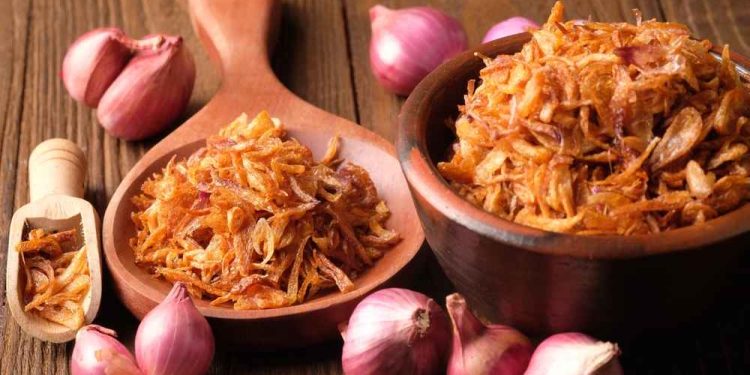Jakarta, Indonesia Sentinel — Indonesia’s beloved condiments—fried shallots, sweet soy sauce, and serundeng—have earned spots on Taste Atlas’s list of the 20 Best Condiments in the World for 2024. The global food-ranking site updated its prestigious list on November 15, celebrating the diverse flavors that enhance dishes across cultures.
Fried Shallots: A Crunchy, Flavorful Garnish
Fried shallots, a simple yet essential ingredient in Indonesian cuisine, topped the list as one of the most celebrated condiments. This traditional garnish is made by slicing shallots thinly before frying them until golden brown. The resulting crispy texture and slightly bitter, savory flavor are key to enhancing dishes like nasi goreng (fried rice), sate ayam (chicken satay), and various soups like sop buntut (oxtail soup).
While fried shallots are often associated with Indonesian meals, their appeal extends beyond the country’s borders. Their crunchy texture and robust flavor make them a versatile topping for global cuisines, earning them acclaim from food enthusiasts worldwide.
Serundeng: A Toasted Coconut Delight
Serundeng is another Indonesian treasure that made the list. Originating from Java, this condiment is a fragrant blend of toasted grated coconut mixed with an array of spices, including turmeric, lemongrass, garlic, coriander, and galangal. This blend results in a rich, aromatic topping often used to accompany rice dishes like ketupat (rice cakes) or savory soups such as soto.
The addition of roasted peanuts in some variations adds a satisfying crunch, complementing the nutty sweetness of the toasted coconut. Serundeng is not just a condiment but a reflection of Indonesia’s spice-rich culinary heritage.
Sweet Soy Sauce: Indonesia’s Liquid Gold
Known locally as kecap manis, sweet soy sauce is arguably Indonesia’s most popular condiment, both at home and abroad. This thick, syrupy sauce owes its sweetness to palm sugar, while its depth of flavor comes from aromatics like cloves, cinnamon, and star anise.
Kecap manis is a staple in dishes like nasi goreng, ayam kecap (soy sauce chicken), and semur (beef stew). Its versatility also makes it a favorite dipping sauce and marinade, adding a caramelized sweetness to grilled meats and vegetables.
Interestingly, the Dutch colonization of Indonesia introduced this condiment to Europe, particularly the Netherlands, where it remains a beloved staple in Dutch-Indonesian fusion dishes.
Global Recognition for Local Treasures
Taste Atlas’s inclusion of these three condiments underscores Indonesia’s rich culinary heritage and its global influence. These ingredients not only elevate Indonesian dishes but also highlight the country’s unique ability to combine simplicity with bold flavors.
Other condiments on the list include Aceto Balsamico Tradizionale di Modena (Italy), gochujang (South Korea), and miso (Japan), emphasizing the global love for ingredients that enhance traditional foods.
Indonesia Rp50,000 Banknote Named the Second Most Secure Currency Worldwide
The Significance of Culinary Recognition
For Indonesian food enthusiasts and culinary advocates, the acknowledgment by Taste Atlas is a moment of pride. The ranking provides a platform to showcase Indonesia’s vibrant food culture to a global audience, inspiring chefs and food lovers to explore the nation’s unique flavors.
As the world continues to embrace international cuisines, staples like fried shallots, serundeng, and sweet soy sauce remind us that the heart of a dish often lies in its condiments—small yet transformative elements that bring depth and soul to every bite.
(Becky)


























